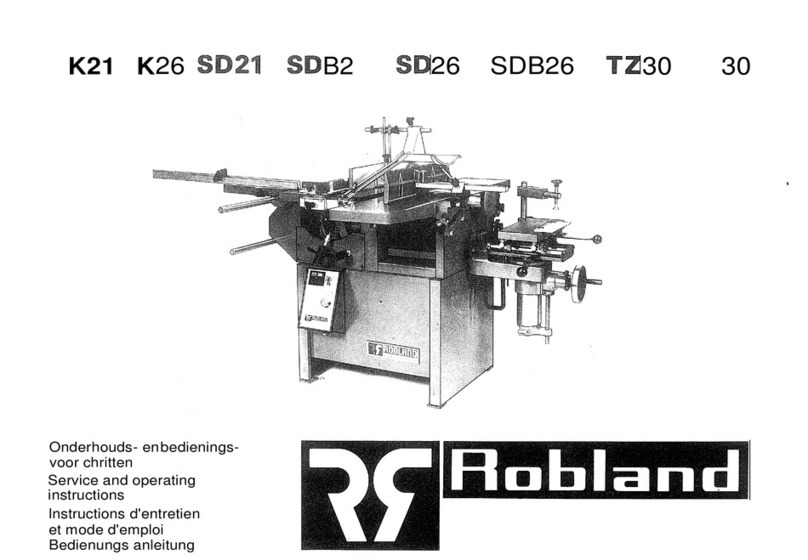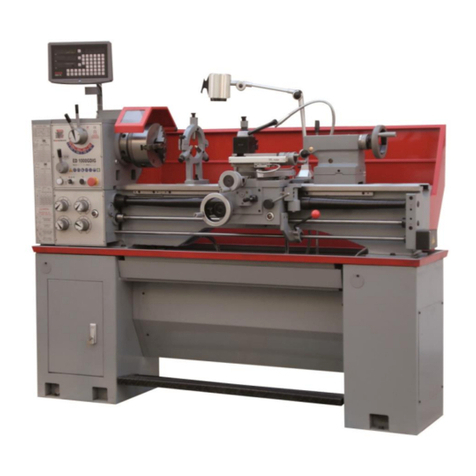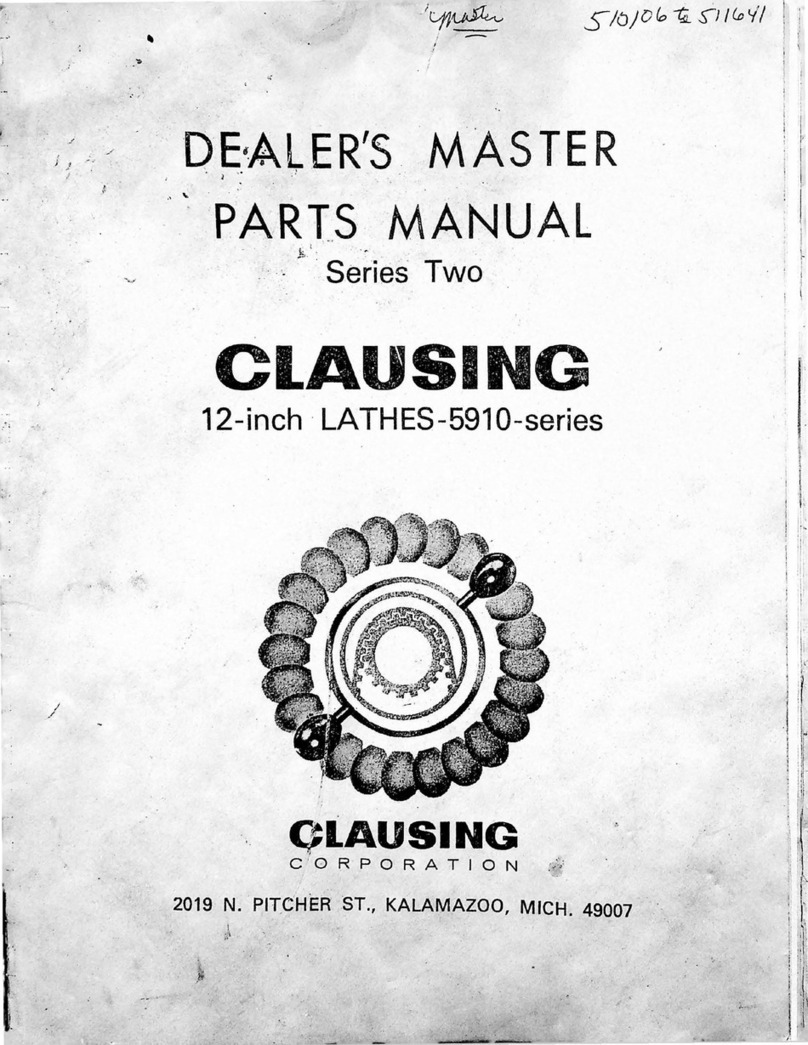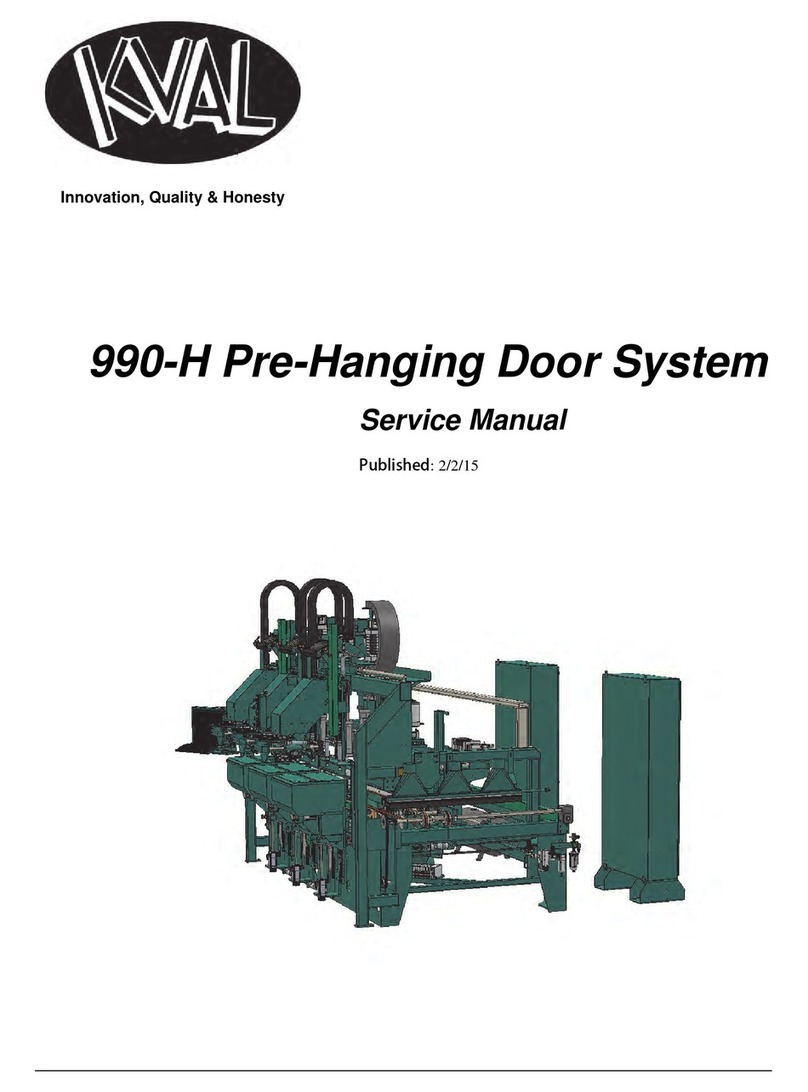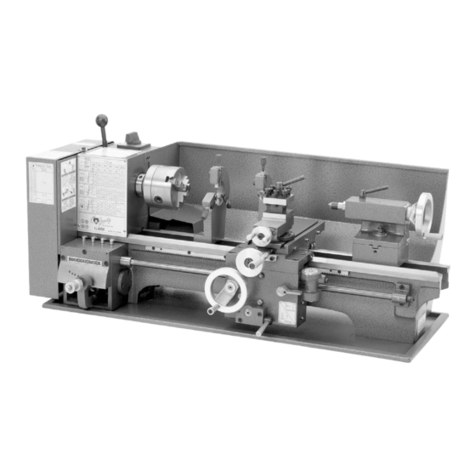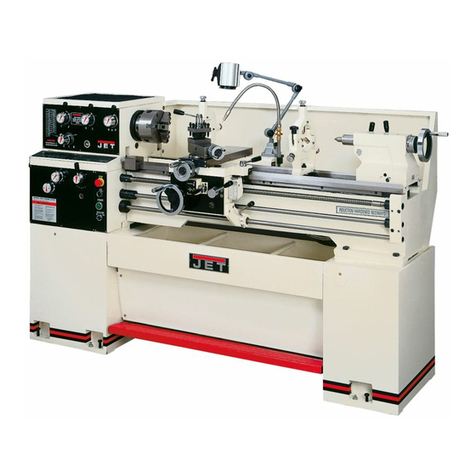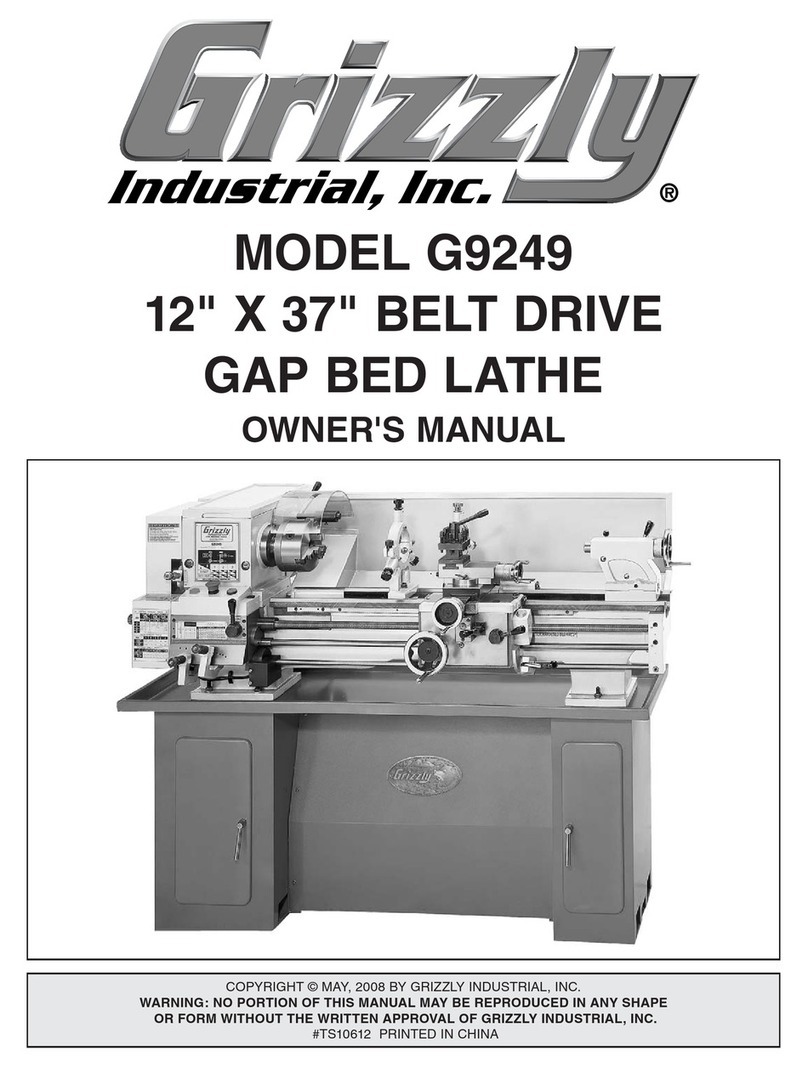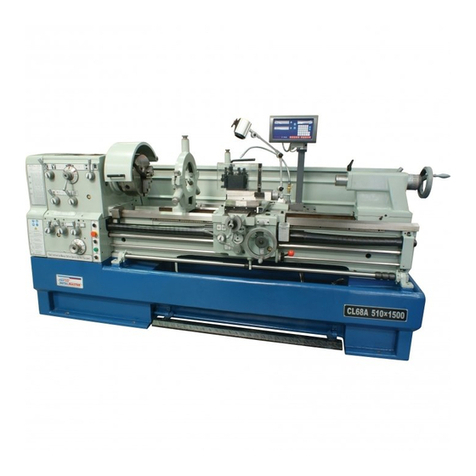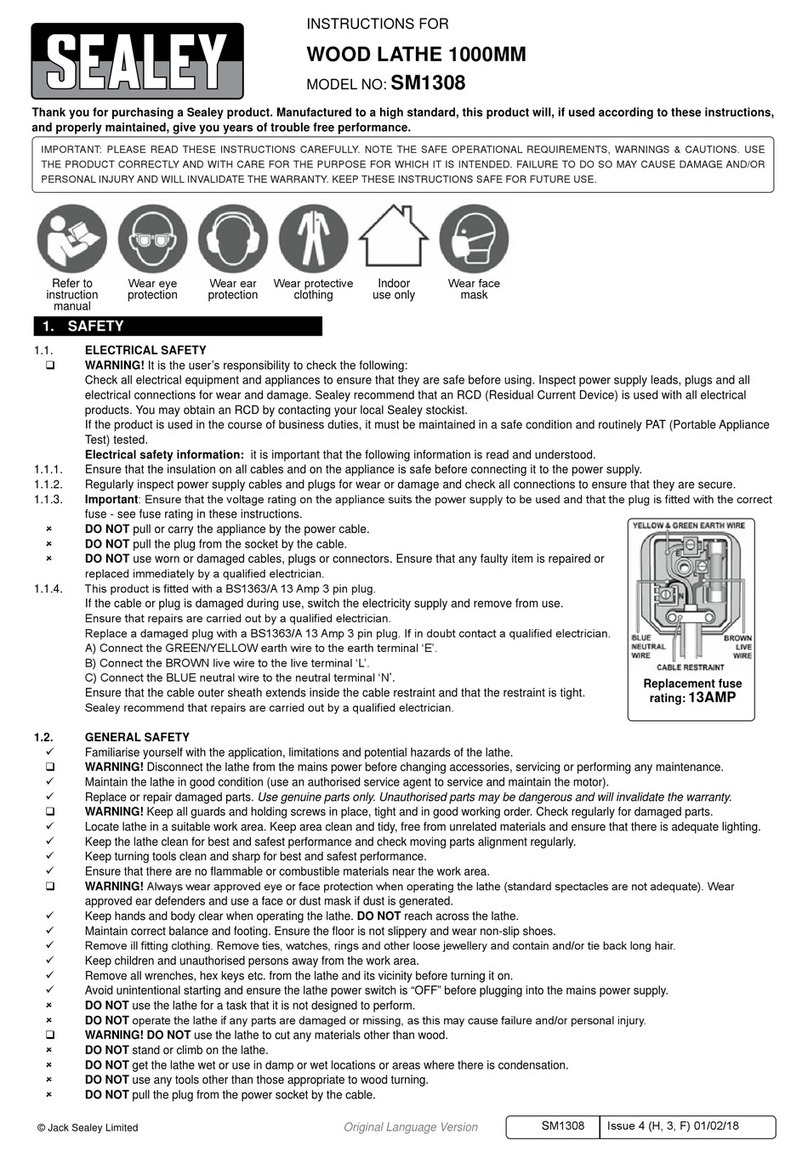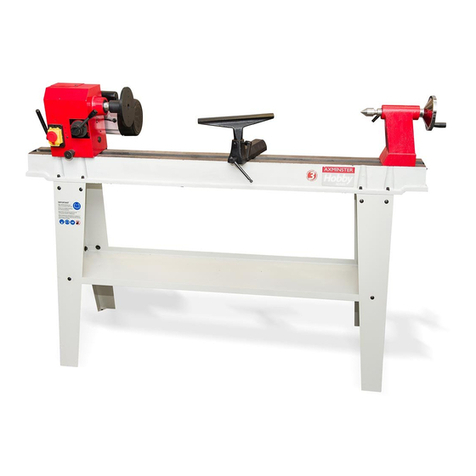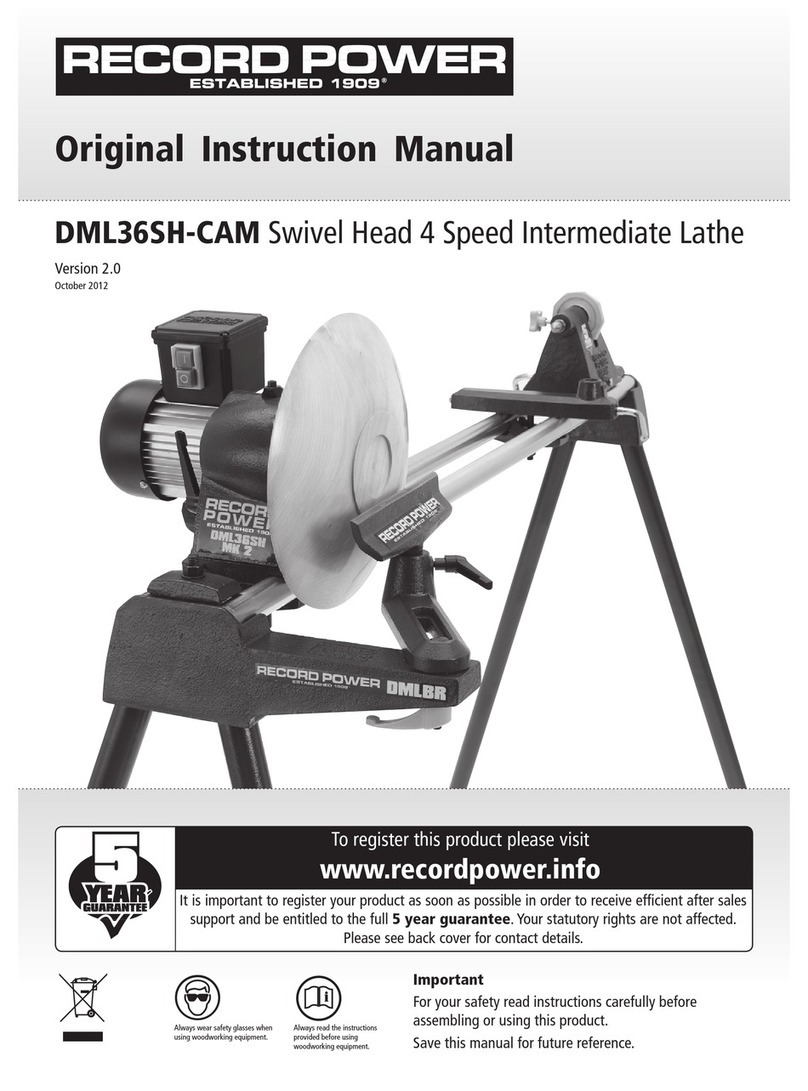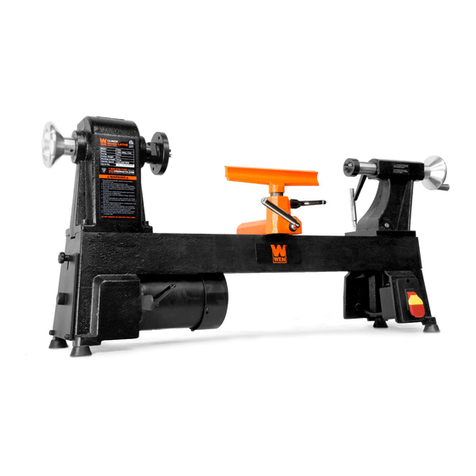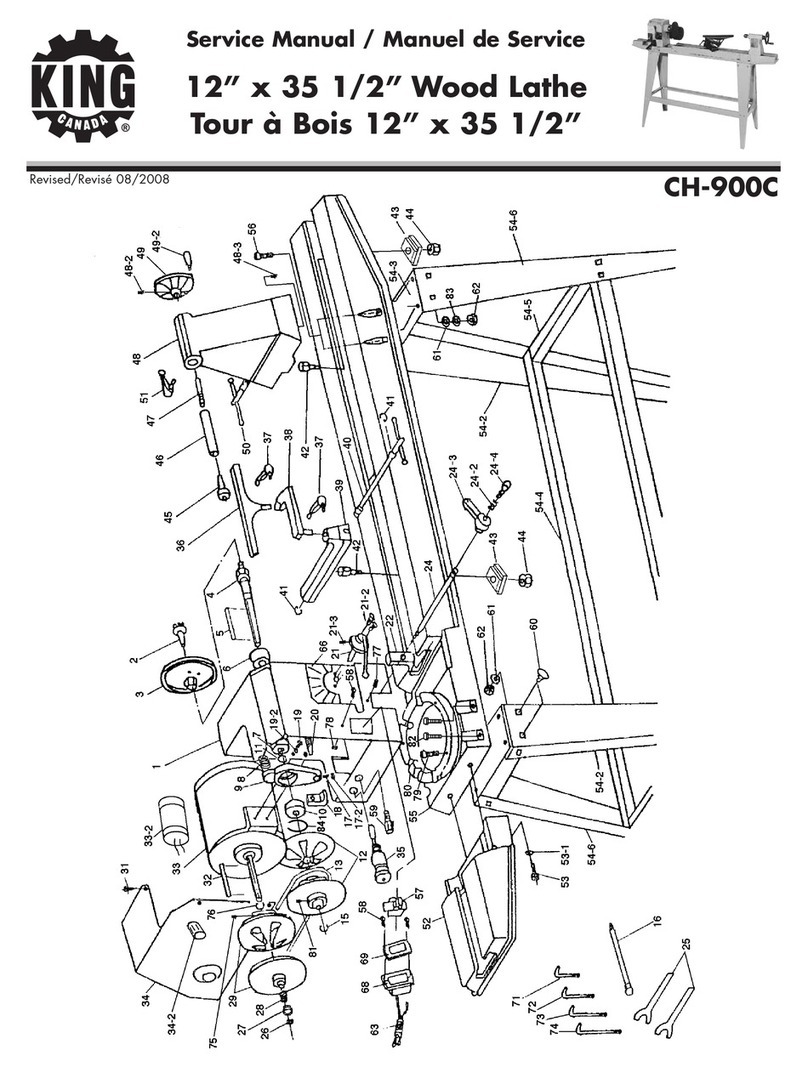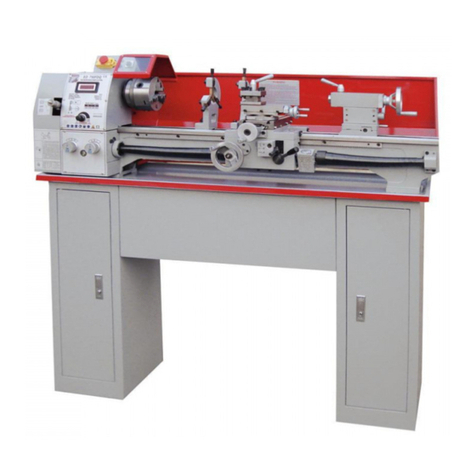Robland M500 M User manual

1
Index
Index..................................................................................................................................................1
Important instructions when ordering spare parts................................................................................2
Safety and maintenance instructions ..................................................................................................2
Danger list..........................................................................................................................................3
Operating instructions ........................................................................................................................3
Normal and prohibited use .................................................................................................................4
REMAINING RISKS...........................................................................................................................4
Explanation of acoustic levels.............................................................................................................5
General dimensions ...........................................................................................................................6
Technical Data...................................................................................................................................7
Transportation and installation of the..................................................................................................8
Electrical connection (Fig.3) ...............................................................................................................8
Mounting the sliding table (Fig.4)........................................................................................................9
Starting the machine (Fig.5-6)..........................................................................................................10
Changing main sawblade (Fig.9)...................................................................................................... 10
Use and adjustment of the riving knife (Fig.10-11)............................................................................11
Lower sawblade cover......................................................................................................................12
Adjusting the main sawblade............................................................................................................12
Adjusting the main sawblade M500EL..............................................................................................13
Blocking the sliding table (Fig.14).........................................................................................................13
Mounting of the cross-cut table (Fig.17)................................................................................................14
Mounting of the cross-cut fence (Fig.18A-B)...........................................................................................14
Use of the parallel fence (Fig.24A-B)................................................................................................15
Calibration of the scale on the parallel fence (Fig.23-25)...................................................................16
Cutting with mitre fence (Fig.24).......................................................................................................16
Using the saw guard (Fig.26A-26B-27).............................................................................................17
Belt tension (Fig.28-29)....................................................................................................................18
Adjusting the brake of the saw motor................................................................................................18
Maintenance of the machine............................................................................................................. 19
Problems: causes and solutions.......................................................................................................19

2
Important instructions when ordering
spare parts
Always mention the following items on your order:
- Type and serial number of the machine
- Serial number from manual
- Part number and quantity
- Your reference and correct delivery address.
Safety and maintenance instructions
- The risks associated with using woodworking machinery are high since they use high-speed
sharp cutters to do the job and in many cases these are necessarily exposed to enable the
machining process to take place. Also, because many machines are still hand-fed, woodworking
is probably the main industry where the hands of the operator are constantly exposed to danger.
- As well as the high risk of injury from contact with the cutters, there is the risk of being injured by
the ejection of the workpiece or cutters (or parts of them) from the machine. No two pieces of
wood are the same; each piece behaves differently when machined or shaped during the
production process. Knots and natural changes in the direction of the grain can give rise to
snatching and kickback of the workpiece.
- Serious risks are related to the use of woodworking machinery, which are sharp, vibrant and noisy
machines. The machine can only be used safely if the operator strictly follows the operating and
safety instructions. It is essential to read this manual before using the machine so you know how
to the machine works and what its limitations are.
- Provide sufficient space around the machine and a good lighting of the workshop.
- Always make sure that all safety devices are fitted to the machine and that the machine is
connected to a dust extraction system.
- Keep dust levels down with good housekeeping. Keep the work area clean so you do not
resuspend dust into the air while working. Never use compressed air to clean the work area or
clothing, because it generates dust. Wood dust is harmful by inhalation and in contact with skin for
all woods, but more or less according to the varieties of types (deciduous, conifers, exotic) and
chemicals potentially associated (including formaldehyde in MDF).
- Exposure to wood dust and many chemicals (solvents, adhesives and varnishes...) generate a
risk of allergic reactions, respiratory and sinus cancer.
- Use a dust mask and hearing protection when working with the machine. To avoid inhalation of
wood dust many types of masks and filters are available. A good choice and application are
important for proper operation.
- Carefully read the instructions for the cleaning of the machine.
- Do not remove by hand wood residues to a running engine. Do it only with a fully disabled
machine. When changing tools or when doing a maintenance job, the machine must always be
disconnected from its power supply.
- Knives and tools which are not correctly sharpened, or in a bad shape, not only diminish the
quality of the work, but also increase the risk of accidents. Only use sharpened tools confirm to
EN 847-1:2017
- Always wear suitable clothing, loosen or torn clothing is dangerous.
- Keep children and non-trained personal away from the machine and out of the workshop.
- Always use templates during the machining of special parts.
- Be sure to use only blades corresponding to the dimensions indicated in the technical data and
relevant to your work.

3
- Make sure that periodic maintenance be carried out in due time. Try out weekly the emergency
stops. Read the instructions of maintenance and adjustment of the automatic brake of the motor.
Check if the automatic braking of the motor time is less than 10 seconds, if the emergency stops
functioning correctly.
- All guards need to be kept in a good working condition and need to be checked regularly to
ensure that they move freely, are free from any defect and are capable of being adjusted over the
full range of work for which they were designed.
- Maintenance work should only be carried out by people who have the combination of training,
skills, experience and knowledge to do the work.
- Use only tools for manual use with a maximum width of 16 mm on the machine that is equipped
with the “groove milling” option and which are manufactured according to EN 847-1: 2017 and are
marked with “MAN”.
Danger list
This list was based on C-norms EN ISO 19085-5.
Mechanical risks caused by, for example:
- the shape, the mass and the stability (potential energy of the elements), relative disposition, the
mass and speed (kinetic energy of the elements), insufficient mechanical resistance,
accumulation of potential energy of the elastic elements (springs), elements of the machine or
machined pieces
- Risk of crushing
- Risk of cuts
- Risk of gasping, wrapping
- Risk of electric shock or pinching
- Ejection of elements (of the machine or of the processed part), electrical risks, caused by
electrical contact (directly or indirectly)
- Risks caused by noise, materials or inhalation of toxic substances
- Risk of fire or explosion
- Combination of risks
- Risks caused by failure in the supply of energy, defect of elements of the machine and other
functional disorders, for example all types of safety devices, safety equipment and start / stop
equipment.
- Safety signals and pictograms and all types of information or equipment.
Operating instructions
The following recommendations for safe working procedures are given as an example, on top of all
information characteristic of this machine.
- When working with the machine, safety equipment must be used.
- Nevertheless, the user must also follow the operating instructions to avoid accidents.
1 Training of machine users
It is absolutely essential that the panel saw user receives thorough training regarding operating and
adjusting the machine.
In particular:
a) the risks involved in working with the machine;
b) the operating principles, the correct usage and adjustment of the machine;
c) the correct choice of the tools for each operation;

4
d) the safe handling of parts to be processed;
e) the position of the hands in relation to the sawblade;
f) storing the workpieces safely before and after sawing them.
2 Stability
In order to be able to use the machine safely, it is essential to place it stably on the ground or other
stable surface.
3 Adjustment and installation
a) Disconnect the machine from the power supply before every adjustment.
b) The recommendations of the manufacturer must be followed when adjusting and installing the
tools.
c) The tools must be suited to the material being cut to assure safe and efficient sawing. The tools
must be correctly sharpened and installed.
4 Handling of tools
In order to avoid severe cuts, safety measures must be taken when handling the sawblades.
5 Intended use of the machine
The machine may only be used for processing all types of wood, panels and sheets with or without
plastic coating. The processing of plastic sheets and plastic is permitted with adapted saws. The
machining of ferrous and non-ferrous metals is strictly forbidden. In order to be able to maintain the
indicated sound values, all protective caps and means provided on the machine must be used. This
also applies to the dust emission and means that the machine must be connected to a dust
extraction system, whose air flow rate measured at the extraction opening on the machine is at least
20 m / sec. amounts.
Normal and prohibited use
The panel saw is designed for the following work and is equipped with protective devices for these
processes only. It is not designed to work materials such as ferrous or non-ferrous metals, work
different from that stated below is prohibited.
- Ripping with the parallel saw fence with/without the sawblade tilted and the fence upright or in the
low position.
- Right-angled or mitre cuts with the 90° fence mounted to the sliding table with tilted or vertical
sawblade.
- Cross-cutting workpieces using the adjustable stop on the 90° fence. - Cutting panels or
solid wood on the sliding table.
PROHIBITED USE
Following tasks are prohibited on the panel saw:
- submerged cuts by removing the riving knife and/or guard;
- all types of cuts without using the table saw fence, the 90° fence or sliding table; Cutting large
workpieces that exceed the machine capacity without using aids such as roller supports.
REMAINING RISKS
The most important risks on the panel saw are:
- unintentional contact of the hand with the saw blade;

5
- contact with the saw blade during the stop time of the saw blade (10 sec). - recoil of the
workpiece or recoil of parts within the workpiece - tilting of the workpiece due to insufficient
support.
- Injuries due to tool breakage or parts that break off the tool.
- Injuries in the non-secured area between the machine table and the saw blade during sawing
parts.
- Risk of pinching and crushing between the parallel fence and the sliding table
- Risk of pinching and crushing between the parallel fence and the saw blade, riving knife and saw
blade.
- When moving the sliding table, there are risks for clamping, pinching and crushing. Only use the
handle to move the sliding table.
- When cutting plastics, there is a risk of the release of harmful substances.
- Risks due to changes made to the machine by unauthorized personnel.
- Risks for the machine, tools and safety equipment when tilting the blade while the saw blade is
rotating.
- Risks for the machine, tools and safety equipment when setting the parallel fence with rotating
saw blade.
SOUND REDUCTION
- The type and condition of the saw blade is important to keep the noise level as low as possible.
- The material and the position of the safety devices are important for reducing the noise level.
Using the correct speed of the saw blade for the type of material will reduce the noise level.
- The above does not mean that no additional protection measures such as hearing protection
should be used.
Explanation of acoustic levels
The values given are the emission values and not necessarily the safe working levels.
Although there is a relationship between the emission values and the level of exposure, this can not
be reliably used to determine whether additional measures need to be taken.
Measurements according: NBN EN ISO 3746 (2011)
NBN EN ISO 11202 (2010)
Measurements performed by: Vinçotte nv
A measurement uncertainty tolerance of K = 4 dB (A) applies to the indicated emission values.
Workstation
Level acoustic load
dB (A)
Level acoustic power
dB (A)
Sawing
92.1
100.1

6
General dimensions

7
Technical Data
Voltage
Motor power
Weight
Saw
Diameter saw and bore
Cutting depth at 90° / 45°
RPM
Sawblade tilting
Cutting width parallel fence
Dimensions table
Dimensions sliding table
dimensions cross-cut table
Diameter aspiration tubes
Motorized rise and fall of the saw
Motorised tilting of saw aggregate
Preparation groove cutter
Mitre fence on sliding table
Extra support table with rip fence
Eccentric clamp
Digital read out of tilt of the saw aggregate
Digital read out of height of saw blade
Digital read out on parallel fence
230V / 400V
9,2 kW (S6) (12,5pk)
550kg
300 - 500 x 30 mm
175 mm / 122 mm
3000 / 4000 / 5000
90° - 45°
1000/1350mm
985 x 710 mm
1150x 420 (optie 2200) mm
mm
120 + 100 mm
M500 EL
M500 EL
Option M500 EL
Option
option
standard
Option
option M500 EL
option M500

8
Transportation and installation of the
machine (Fig.1-2)
Depending on the transport or shipping method you will receive the machine either in a box or not
packaged. The packaging itself, made of sturdy fibre boards and the wooden beams, can easily be
reused. You can lift the machine with a crane or forklift truck and bring it to the ground. On the front of
the frame there are two openings with which you can move the machine with a hand pallet truck.
(2) Ensure that the machine is well balanced in the lifting belts when moving. Secure the belts against
lateral shearing.
ATTENTION:
Always check if the payload of your hoist is large enough.
After unpacking, check that the machine has not been damaged during transport or during unloading.
Place the machine stably on a solid surface and provide sufficient space around the machine to work
in a safe manner. The machine must be levelled in both directions. There are 6 adjusting bolts on the
machine, see fig.2
Electrical connection(Fig.3)
The electrical connection must be carried out by a qualified electrician who is able to calculate exactly
the required wire cross-section and capacity of the workshop fuses.
Check that the main voltage of the machine corresponds with the voltage supply to your workshop.
Now open the electrical switch panel and introduce the cable. Connect the 3 phases to the terminals
on the connection block marked L1, L2, L3. If there is a neutral conductor it must be connected to the
terminal N.
Connect the earth wire (green-yellow) to the terminal marked with the earth symbol PE.
ATTENTION:
- Check first if the saw spindle runs freely and if all safety devices are fitted before starting the
machine.
- If the direction of rotation of the sawblade is not correct, the wires L1 and L2 must be exchanged
(clockwise direction of the spindle is correct).
- For safety reasons this must only be done without the sawblade on the spindle !

9
THERMAL OVERLOADS
The machine has overload protections on both saw and scoring motors. Should the motor be shut-off
by one of these protectors, it is necessary to wait a few minutes until the overload has cooled down.
Mounting the sliding table(Fig.4)
To obtain a good arrangement and function of the sliding table; it is vital that the machine is put on a
right level in both directions, with the help of a level, before putting the sliding table on the machine. All
the adjustments and arrangements are done in the factory. Simply put the table onto the frame with
the two lateral adjustment bolts (1) into the two lugs of the frame. Be sure that the girder rests well in
the height adjustment bolts. Now place the 4 big Allen bolts (3) and tighten well. In order to obtain a
good movement of the wood or the sliding table, the sliding table is set near to 2 mm above the
sawing table. The parallelism between the principal blade and the sliding table, can be corrected by
using 2 bolts. After the adjustment, the 4 bolts need to be tightened well with a Torque wrench with a
value of 7 kg (70 Nm). The adjustment in height of the sliding table can be done by using 8 bolts (2)
but always with the big bolts closed.
Fig.4

10
Starting the machine(Fig.5-6)
Set main switch (1) to “1” to energize the machine (fig. 6.1).
For model M500 fig (5A) and model M500 EL fig (5B). Start the main engine (white button) and stop
(black button) with the button (3).
The upper white button starts the engine, the lower black button stops the engine.
When the emergency stop (1) is pressed, both motors are switched off. The main saw motor is
equipped with an automatic brake which slows down the motor within 10 seconds as soon as the
machine is shut off.
ATTENTION:
When the machine access door is open, the saw blade cover is open, or one of the emergency
stops is pushed in, the machine cannot be started.
All fuses are located inside the electrical panel and each time this panel is opened the machine
has to be disconnected from its power supply.
Fig.6
Changing main sawblade(Fig.9)
Warning: Before changing sawblades always turn off the main switch.
Handle sawblades with care, to avoid serious cuts and injuries.
Push the sliding table to the rear and open the saw cover. Raise the main sawblade to its highest
position and put the key(2) into the saw spindle nut.

11
Put the locking pin in the opening of the saw table and turn the spindle with the key (3) until the locking
pin (2) engages in the hole in the saw spindle pulley.
Now unlock the nut (1). Before fitting the new sawblade ensure the blade and flanges are clean. This
prevents wobbling of the sawblade.
Never forget, after the saw spindle nut has been tightened, to remove the locking pin from the pulley
before starting up the motor.
ATTENTION:
Only saw blades with a diameter of 300 to 400 mm may be placed on the machine.
The use of HSS saw blades is strongly prohibited, as well as the use of deformed or cracked saw
blades. Only use saw blades in carbide!
Also make sure that the saw blades are always sharp and cut according to the manufacturer’s
specifications.
WARNING:
All main sawblades which are used on the panel saw must have two additional holes in the sawblade
body, to prevent the sawblade from loosening when the rotation of the saw spindle is stopped by the
brake on the motor.
The two little bolts in the fixed saw spindle flange prevent the saw from coming off and may under no
circumstance be removed.
Fig.9
Use and adjustment of the riving
knife(Fig.10-11)
The machine is equipped with two riving knives for the use of sawblades from 300 to 500 mm. The
riving knife has to be adjusted in such a way that over its entire length the gap between sawblade and
riving knife does not exceed min.3 mm and max.8
mm.
The riving knife can be adjusted in both vertical and
horizontal direction.
In the upper range, the riving knife must be adjusted
so that the top is between 0 mm and 2 mm below
the highest tooth of the saw blade.
After height adjustment always lock the central bolt
(3) at a torque of 60 Nm. The 4 adjustment screws
(2) are used for the exact setting of the riving knife
in line with the sawblade.

12
Never remove this riving knife. Kickbacks are severe and very dangerous !!
Lower sawblade cover
In the event of a saw blade change, the sliding table must be pushed fully to the rear in order to be
able to open the saw blade cover.
The sawblade cover is held by 2 magnets.
If the cover is open, the saw cannot be started.
Adjusting the main sawblade
M500(Fig.12A-B)
The main saw blade can be adjusted vertically with the handwheel (1) and the handle (2
The height adjustment of the scoring saw is done with the adjusting knob (5). (fig 12A)
Lock the setting with the serrated nut (4). (fig 12A)
The desired cutting angle can be set with the handwheel (1) and the handle (2)(Fig 12B). The angle
setting can be read on the clock (4) in the handwheel. The angle of the scorer blade is automatically
adjusted according to the angle setting of the main saw blade. The sawing unit can be adjusted to
angles between 45 ° and 90°. Mechanical stops have been adjusted from the factory to the end points.
Fig.12A Fig.12B

13
Adjusting the main sawblade M500EL
Adjusting height (Fig.5B and 5C)
Changing the height of the main sawblade can be done with the help of push buttons.(4 and 5).
To recover the backlash of the transmission; always adjust the height of the blade in <<up>> mode.
Adjusting the inclination of the saw unit (Fig. 5B and 5C)
The inclination of the main sawblade can be done with help of push buttons.(6) The inclination of the
saw unit is visualized on the indicator or on the digital screen (9) for the machines equipped with this
part. The saw unit can be inclined in angles of 45 and 90° and at those two points, there are
mechanical stops provided by the factory.
Blocking the sliding table (Fig.14)
- The sliding table can be blocked in two positions and with one block-system. This is vital for
example by loading of the boards or cutting along the parallel guide. The system is located on the
front-side of the sliding table. Pull the button (1) in your direction and turn to the right to liberate
the table. Pull the sliding table till end, the table will be blocked automatically when arriving in the
exact position. Continue this way to start working.
- When several movements are repeated consecutively, it is possible that the bearing cage
between the two profiles moves a little bit. We can note this as well by a reducing travelling
distance of the sliding table. To proceed and achieve the normal travelling distance of the sliding
table, you can adapt the position of the bearing cage: simply push the table with a few short, light
pushes against the buffer stop at the end of the sliding table until the position of the ball carrier is
adjusted and the table can be moved again along its full stroke.
Attention: cleaning and maintenance of the sliding table
It is vital to regularly blow away the saw- and other dust, collected between the sliding table
and the bearing cage. Push the sliding table to the end, to get a better reach towards the rails,
the bearing cage and gliding tracks. Oil serves to lubricate the sliding rails and is an extra
guarantee of good use and function.

14
Mounting of the cross-cut table (Fig.17)
The cross-cut table can be mounted on the sliding table as follows: make sure that both mounting
brackets are well placed in the lateral groove of the sliding table.
The locking itself is done with the two locking handles (1). Make sure the cross-cut table rests well on
the vertical post of the telescopic arm. The machine serves only to put the cross-cut table at the back
of the sliding table, with a maximum at the centre.
The cross-cut table and fence are factory set at 90° to the saw blade but if for some reason this is not
the case and not exact anymore, the 90° angle setting adjustment is done by loosening the 4 bolts (2)
and shifting the complete cross-cut table. Make sure these 4 bolts are well tightened after the
adjustment is done. The cross-cut table can only be mounted at the end of the sliding table. To put it
more forwards (max. in the middle), use the optional longer telescopic tube.
Mounting of the cross-cut fence (Fig.18A-B)
To place the cross-cut fence on the cross-cut table, place the fence with the right hinge pin (1) in the
fastening hole on the front of the table (fig. 18B). Now place the clamping screw (2). Slide the fence
backwards until the stop bolt (3) is securely in the rear support point (4) and the stop bolt (5) in the
support point. These support points also serve as a 90 ° stop. The support point (4) is set fixed but
can be adjusted if desired, but it does not serve to adjust the squareness of the fence, this is done with
4 adjusting bolts (fig 17, 2), but to adjust the rear fastening point without play. The fence can be used
in 2 positions at the front or the rear, and at an angle. All attachment points are factory-set.
There is an optional index system for the fence. This allows you to cut accurately at an angle and have
a correct length reading on the fence. Loosen the 3 clamping screws loosely, push the stop beam
forward so that it is free from the support point (4). Now the fence can be moved at an angle. The
angle can be read on the measuring scale (7). Now pull the fence backwards until the stop (5) falls
into one of the notches on the index plate (8). Now you are sure of angle and length. Now the
clamping screws (2 and 6) can be fixed again.

15
Abb.21
Use of the parallel fence(Fig.24A-B)
When the serrated knob (3) is unlocked and the handle (1) is lifted up, the complete parallel fence can
be moved. To lock the fence in position push the handle (1) down.
The micrometric adjustment is achieved by locking the knob (3), by holding the handle (1) in the
upright position and by turning the serrated knob (2).
After the adjustment, push handle (1) down to lock the fence in place. When cutting small workpieces
with the saw unit inclined at 45°, the fence should be used in the low position.
Simply unlock the eccentric clamping handle (4), slide off the fence and slide it back on in the low
position. Lock the fence with the eccentric clamping handle (4).
When cutting solid wood using the parallel fence, to avoid the wood getting stuck between the fence
and the riving knife (resulting in a highly dangerous kickback) it is recommended to reposition the
fence so that its end protrudes just past the end of the riving knife.

16
Calibration of the scale on the parallel
fence(Fig.23-25)
Each time a new sawblade is fitted the parallel fence scale has to be calibrated to the new sawblade.
By cutting a sample and measuring its exact length, the scale can be adjusted so that the exact
measure corresponds with the front side of the fence.
After the screw (1) has been loosened the scale can be adjusted. To avoid the fence contacting the
sawblade while it is revolving, the stop ring (2) has to be adjusted. Slide the fence to about 10 mm
from the sawblade. Now slide the stop ring (2) across the round guide bar (3) until it comes up against
the casting of the fence. Tighten the lock screw on the stop ring.
For a digital reading: Move the parallel fence against the saw blade, and then simultaneously press
the “F” and “SET” buttons. The value on the digital reading jumps to “0”.
Then shift the locking ring (fig. 25.3) onto the saw guide (2) until the cutting width is limited to 2 mm.
This prevents inadvertent contact with the saw blade.
If the size display is not correct when the digital display is read, check the distance between the
sensor (Fig. 23.2) and the digital measuring tape (Fig. 23.1). This may be max 0.2 mm. If necessary,
adjust this with the adjusting bolts (fig. 23.3).
Cutting with mitre fence(Fig.24)
The nut for receiving the wood clamp shaft (1) is set from the factory and must not be moved. The set
angle can be read at the rear of the large angle bracket (4). The angle is changed by unloading the
shaft (1) and releasing the clamping lever (2). The stop profile (5) itself can be moved by releasing the
2 clamping levers (3).

17
Fig.24
Using the saw guard (Fig.26A-26B-27)
For safety and health reasons, the saw cover must be connected to a dust extraction system. This
must have a flow rate of min 1200m³ / h at 20 m / s.
The connection at the bottom of the saw unit has a diameter of 120 mm, on the saw guard (via the
support pipe) with a diameter of 100 mm. The saw guard itself must be set so that the saw blade and
the scoring blade are protected and the piece to be machined can be moved just under the cover. The
height adjustment of the hood is done by pulling back the pin (fig. 27, 2). With normal use pull the pin
(fig. 27,2) backwards and lower the saw blade onto the work table. The saw cover will automatically
raise when entering workpieces up to a certain thickness. For workpieces where a larger cutting height
is required: grasp the saw blade on the handle (4), pull the pin (2) back and place the saw blade in the
desired position. Push the clamping pin 2 forward again and the saw blade is fixed. The saw cover can
no longer lower, but will go up if a higher workpiece is inserted. To lock the saw blade in both
directions, screw in the clamp pin (fig. 27,1). To set a maximum cutting height, place the ring (3) in the
desired position.
The saw blade has a narrow cover for sawing under 90 °. To place it, slide the plate (fig 26A, 1) down
into the key holes and attach the 2 clamp screws (26A, 2).
The wide hood serves for cutting under 45 °. This is also fixed with 2 clamping screws (fig 26B, 2) and
also slides into 2 key holes.

18
Fig.27
Belt tension (Fig.28-29)
Raise the motor via the handle (29.2). Now the belt can be placed in the desired slots (fig. 28). Lower
the motor until the belt has the correct tension. A properly tensioned belt can be pressed in the middle
under slight pressure over approximately the thickness of the belt. A belt that is too tight leads to
damage to bearings and premature wearing of the belt.
Check the condition of the belt regularly and change if necessary (order number: NXPA800). Only use
Robland replacement parts.
Adjusting the brake of the saw motor
If the run down time of the saw motor exceeds 10 seconds, then the brake will need to be readjusted.
This is done as follows: without removing the motor cowling, turn the bolt holding the ventilator fan on
the motor axle one 1/16th of a turn clockwise and make a brake test. When needed adjust the brake
furthermore untill it does not exceed 10 seconds.
The air gap between ventilator fan (brake disk) and brake liner (Ferrodo) is factory set at 0,25 mm, this
under normal conditions.

19
Maintenance of the machine
All maintenance and cleaning work may only be carried out with the main switch set to “O”. The
machine must have been switched off from the mains.
In order to guarantee the life of your machine and also to optimize the quality of your delivered work,
we strongly recommend cleaning the machine once a week and remove all dust and chips that have
accumulated on different parts of the machine.
Especially the carriage must be well maintained. To do this, slide the trolley to the rear and carefully
blow all dust and dirt from between the two profiles and ball cage. Afterwards the steel carriages of the
car must be lubricated with a simple lubricant in spray such as WD40 or other means.
All ball bearings used in the machine are dust-tight and require no lubrication.
Remove any resin deposits on the machine and regularly lubricate the steel axle of the parallel fence.
Caution: when using solvents, be very careful about the risk of fire. !! Do not smoke and keep
the products away from heat sources !!
Problems: causes and solutions
1 The machine does not start when the start button is activated:
- access door is still open: close the door correctly
- main fuse is switched off: power cut, power shortage or motor overload
2 Reduction of speed when working:
- belt tension not correct: tension the belt
- motor overload due to incorrect feed rate: reduce the feed rate - blunt
tools: sharpen tools
3 Vibration of the sawblade or spindle:
- unbalanced tool: replace or have the tool balanced -
worn or damaged belt: replace the belt
1
Motor frame
2
Key
3
Spring
4
Motor axle
5
Air gap
Electromagnet
6
7
Mobile disk
8
Locking nut
9
Adjustment bolt
10
Washer
11
Braking disk cast iron
12
Brake liner (Ferrodo)

20
4 Thermal overload does not re-arm automatically after shut-off and cooling down period:
-overload is not set on automatic reset or the overload is faulty
If you cannot solve the problem yourself or you do not find your problem in this list, please contact
your Robland dealer.
land-Händler.
This manual suits for next models
1
Table of contents
Other Robland Lathe manuals
